The CEO of Ermenegildo Zegna, the biggest brand in wool marketing, has publicly endorsed the "Uamby Position" on the crisis in the industry.
Count Paolo Zegna di Monterubello says urgent action is needed to save the wool industry. "Wool is in a very deep identity crisis," he told Stock and Land this week.
He agrees with Michael Kiely's position - outlined last week in The Land - that the youth market is wool's great opportunity.
"The younger generation have the most significant buying power," he said. "Unfortunately [wool] is not sufficiently promoted and doesn't speak to them in the right way."
Count Zegna echoed the Uamby Solution - using style-setters that youth follow "like sheep" to give wool garments visibility and appeal. He rejected the current AWI marketing direction which focusses on functional benefits of wool. "He says talk of the breathability of wool is unlikely to impress this market," says the report. "Rather celebrities and sports stars should be encouraged to wear wool garments, with an eye to garment appearance and style."
Zegna has lost faith in AWI's ability to market wool. He is calling for an extra levy to fund a marketing campaign run by the Italians. Count Zegna said he'd be happy to pay the levy because the Australian wool growers are spending too little on marketing. Other wool garment manufacturers would invest "if there is a marketing campaign that makes sense".
"According to Count Zegna, the few million currently invested in marketing is nowhere near enough to create a consumer interest in wool," reports Stock and Land.
This is a stinging indictment of AWI and a ringing endorsement of my position as outlined in The Land last week.
Friday, April 28, 2006
Thursday, April 27, 2006
The day we went to Manly
We decided to spend a weekend in the big city, to get away from the endless happiness of living in the bush. Not content to crawl around the suburbs, we headed straight for the biggest expression of Nature's power in Sydney - the Harbour. And we took a ferry to Manly where we did little else but sit and watch Xavier playing in the sand. It was a coolish day, but he enjoyed getting wet. I amused myself taking photographs of the water. I am in awe of the immense power of water. In future posts i will be revealing the stunning info we have been gathering about water. (It has intelligence. It can hear you. It responds to our emotions and thoughts. We have proof.)
 Homer tells us Ulysses sailed over the 'wine dark sea'. Ulysses is a symbol of everyman's journey through life, searching for himself. What will he do if he every finds himself?
Homer tells us Ulysses sailed over the 'wine dark sea'. Ulysses is a symbol of everyman's journey through life, searching for himself. What will he do if he every finds himself?
 The wild ocean never rests. It is all energy and thrust. It's very male. Yet it is the womb from which all terrestrial life emerged.
The wild ocean never rests. It is all energy and thrust. It's very male. Yet it is the womb from which all terrestrial life emerged.

Every wave is a time/space event which emerges, peaks, and fades away. Like people. We are like waves upon the ocean, we enjoy a brief existence. Then return to the universal source.
 Children have a natural affinity with the shoreline. It calls to them, "Come play with me." Some it takes to its bosom. The sea is a jealous mother - she takes what she can get.
Children have a natural affinity with the shoreline. It calls to them, "Come play with me." Some it takes to its bosom. The sea is a jealous mother - she takes what she can get.
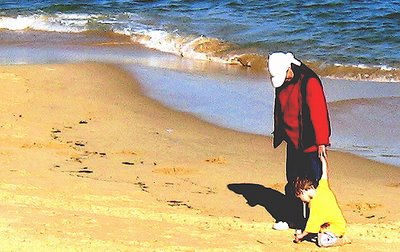 What a grand mother my Louisa turned out to be. If ever I need proof that God loves me, I can think of her.
What a grand mother my Louisa turned out to be. If ever I need proof that God loves me, I can think of her.
 Sand, robbed of a few tonal dimensions and boosted in others. I love the Abstract Expressionists - especially Jackson Pollock. Nature is as good as Jackson. I think I have found my visual art form. Found art. Significant moments. Visually manipulated. I was taught photography at college by an Abstract Realist painter who would paint small sections of an object in a way that presented a beautiful composition, yet revealed to the viewer willing to inspect it closely that it was part of a larger whole. I find the spirit of things in their tiny abstracted parts.
Sand, robbed of a few tonal dimensions and boosted in others. I love the Abstract Expressionists - especially Jackson Pollock. Nature is as good as Jackson. I think I have found my visual art form. Found art. Significant moments. Visually manipulated. I was taught photography at college by an Abstract Realist painter who would paint small sections of an object in a way that presented a beautiful composition, yet revealed to the viewer willing to inspect it closely that it was part of a larger whole. I find the spirit of things in their tiny abstracted parts.
 Homer tells us Ulysses sailed over the 'wine dark sea'. Ulysses is a symbol of everyman's journey through life, searching for himself. What will he do if he every finds himself?
Homer tells us Ulysses sailed over the 'wine dark sea'. Ulysses is a symbol of everyman's journey through life, searching for himself. What will he do if he every finds himself? The wild ocean never rests. It is all energy and thrust. It's very male. Yet it is the womb from which all terrestrial life emerged.
The wild ocean never rests. It is all energy and thrust. It's very male. Yet it is the womb from which all terrestrial life emerged.
Every wave is a time/space event which emerges, peaks, and fades away. Like people. We are like waves upon the ocean, we enjoy a brief existence. Then return to the universal source.
 Children have a natural affinity with the shoreline. It calls to them, "Come play with me." Some it takes to its bosom. The sea is a jealous mother - she takes what she can get.
Children have a natural affinity with the shoreline. It calls to them, "Come play with me." Some it takes to its bosom. The sea is a jealous mother - she takes what she can get. What a grand mother my Louisa turned out to be. If ever I need proof that God loves me, I can think of her.
What a grand mother my Louisa turned out to be. If ever I need proof that God loves me, I can think of her. Sand, robbed of a few tonal dimensions and boosted in others. I love the Abstract Expressionists - especially Jackson Pollock. Nature is as good as Jackson. I think I have found my visual art form. Found art. Significant moments. Visually manipulated. I was taught photography at college by an Abstract Realist painter who would paint small sections of an object in a way that presented a beautiful composition, yet revealed to the viewer willing to inspect it closely that it was part of a larger whole. I find the spirit of things in their tiny abstracted parts.
Sand, robbed of a few tonal dimensions and boosted in others. I love the Abstract Expressionists - especially Jackson Pollock. Nature is as good as Jackson. I think I have found my visual art form. Found art. Significant moments. Visually manipulated. I was taught photography at college by an Abstract Realist painter who would paint small sections of an object in a way that presented a beautiful composition, yet revealed to the viewer willing to inspect it closely that it was part of a larger whole. I find the spirit of things in their tiny abstracted parts.
Wednesday, April 26, 2006
"Eating is an agricultural act."

These words come from Wendell Berry, American poet and farmer. He is still alive and I want to meet him because he has the power to unleash the revolution in the human spirit that is needed to save the environmental foundations on which our society stands.
"The crisis is not in land use. It's in the lives and the minds of land users," he said in a letter that inspired the founding of the Tilth movement in America, the largest alternative agriculture coalition in that country.
Try this: "We have lived by the assumption that what was good for us would be good for the world. We have been wrong. We must change our lives, so that it will be possible to live by the contrary assumption that what is good for the world will be good for us... We must recover the sense of the majesty of the creation and the ability to be worshipful in its presence. For it is only on the condition of humility and reverence before the world that our species will be able to remain in it."
If you are not moved by these words, your cynicism levels are dangerously high for your health.
And this could be the slogan for the Carbon Coalition: "What I stand for is what I stand on."
Wendell Berry: a man of the soil

On July 1, 1974 Wendell Berry spoke at the "Agriculture for a Small Planet" symposium in Spokane, which was one of a series of environmental conferences hosted as part of Expo 74. Wendell's speech that day, and his subsequent letter to members of the symposium staff, inspired the Tilth movement* in the Pacific Northwest. This is an edited extract.
The Culture of Agriculture
In my boyhood, Henry County, Kentucky was not just a rural county, as it still is. It was almost entirely a farming county. The farms were generally small. They were farmed by families who lived not only upon them, but within and from them. These families grew gardens. They produced their own meat, milk and eggs. They were highly diversified. The main money crop was tobacco. But the farmers also grew corn, wheat, barley, and oats; sorghum and hay for forage. Cattle, hogs and sheep were all characteristically raised in association on the same farms. There were small dairies, the milking more often than not done by hand. Those were the farm products that might have been considered major. But there were also minor products, and one of the most important characteristics of that old economy was the existence of markets for those minor products.
In those days a farm family could easily market its surplus of cream, eggs, old hens, and frying chickens. The major motive power for field work was still furnished by horses and mules. There was still a prevalent pride in workmanship, and thrift was still a social ideal. The pride of most people was in their homes, and their homes looked like it.
This was by no means a perfect society. Its people had often been violent and wasteful in their use of the land and of each other. Its present ills had already taken root in it. But I have spoken of its agricultural economy of a generation ago to suggest that there were also good qualities indigenous to it that might have been cultivated and built upon.
That they were not cultivated and built upon-that they were repudiated as the stuff of a hopelessly outmoded, unscientific way of life-is a tragic error on the part of the people themselves; and it is the work of monstrous ignorance and irresponsibility on the part of the experts and politicians who have prescribed, encouraged and applauded the disintegration of such farming communities all over the country into our allegedly miraculous "modern American agriculture."
In the decades since World War II the farms of Henry County have become increasingly mechanized. Though they are still comparatively diversified, they are less diversified than they used to be. The holdings are larger, the owners are fewer. The land is falling more and more into the hands of speculators and professional people from the cities who-in spite of all the scientific agricultural miracles-still have much more money than farmers. There are not nearly enough people on the farms to maintain them properly, and they are for the most part visibly deteriorating. The number of part-time farmers and ex-farmers increases every year. Our harvests depend more and more upon the labor of old men and little boys. The farm people live less and less upon their own produce, more and more from the grocery stores. The best of them are more worried about money and more overworked than ever before. Among the people as a whole, the focus of interest has largely shifted from the household to the automobile; the ideals of workmanship and thrift have been replaced by the goals of leisure, comfort and entertainment-for, as my friend, Maurice Telleen says, "this nation has created the world's first broad-based hedonism."
And nowhere that I know is there a market for a hen or a bucket of cream or a few dozen eggs. Those markets were done away with in the name of sanitation-but to the enormous enrichment of the large producers. Future historians will no doubt remark upon the inevitable association, with us, between sanitation and filthy lucre. It is, of course, one of the miracles of science that the germs that used to be in our food have been replaced by poisons.
In all of this few people whose testimony would have mattered have seen the connection between "modernization" of agricultural techniques and the disintegration of the culture and the communities of farming. What we have called agricultural progress has, in fact, involved the forcible displacement of millions of people.
I remember, during the fifties, the outrage with which certain of our leaders spoke of the forced removal of the populations of villages in communist countries. I also remember that at that same time, in Washington, the word on farming was "Get big or get out"-a policy that is still in effect. The only difference here is in the method: the force used by the communists was military; with us it has been economic, a "free" market in which the freest were the richest. The attitudes were equally cruel, and I believe that in the long run the results will be equally damaging-not just to the concerns and values of the human spirit, but to the practical possibilities of survival.
And so those who could not get big got out-not just in my community but in farm communities all over the country. But bigness is a most amorphous and unstable category. As a social or economic goal it is totalitarian; it establishes an inevitable tendency toward the tyrannical one that will be the biggest of all. Many who got big to stay in are now being driven out by those who are still bigger. The aim of bigness implies not one social or cultural aim that is not noxious. Its influence on us may already have been disastrous, and we have not yet seen the worst.
And this community-killing agriculture, with its monomania of bigness, is not primarily the work of farmers, though it has burgeoned upon their weaknesses. It is the work of the institutions of agriculture: the experts and the agri-businessmen, who have promoted so-called efficiency at the expense of community, and quantity at the expense of quality...
Along with the rest of society, the established agriculture has shifted its emphasis-even its interest-from quality to quantity. And along with the rest of society it has failed to see that, in the long run, quantity is inseparable from quality. To pursue quantity alone is to destroy those disciplines in the producers that are the only assurance of quantity. The preserver of abundance is excellence.
What are the results of such thinking? The results are the drastic decline in farm population and political strength; the growth of a vast, uprooted, dependent and unhappy urban population. (Our rural and urban problems have largely caused each other.) The result is an unimaginable waste of land, of energy, of fertility, of human beings. The result is that the life of the land, which in its native processes is infinite, has been made totally dependent upon the finite, scarce and expensive products of industry. The result is the disuse of so-called marginal lands, potentially productive, but dependent upon intensive human care and long-term familiarity and affection. The result is the virtual destruction of the farm culture without which farming, in any but the exploitive and extractive sense, is impossible.
My point is that food is a cultural, not a technological, product. A culture is not a collection of relics and ornaments, but a practical necessity, and its destruction invokes calamity. A healthy culture is a communal order of memory, insight, value, and aspiration. It would reveal the human necessities and the human limits. It would clarify our inescapable bonds to the earth and to each other. It would assure that the necessary restraints be observed, that the necessary work be done, and that it be done well. A healthy farm culture can only be based upon familiarity; it can only grow among a people soundly established upon the land; it would nourish and protect a human intelligence of the land that no amount of technology can satisfactorily replace. The growth of such a culture was once a strong possibility in the farm communities of this country. We now have only the sad remnants of those communities. If we allow another generation to pass without doing what is necessary to enhance and embolden that possibility, we will lose it altogether. And then we will not only invoke calamity-we will deserve it.
Several years ago I argued with a friend of mine that we might make money by going ahead and marketing some inferior lambs. My friend thought for a minute, and then he said, "I'm in the business of producing good lambs, and I'm not going to sell any other kind." He also said that he kept the weeds out of his crops for the same reason as he washed his face. Surely no one would question that the human race has survived by that attitude. It still survives by that attitude, though now it can hardly be said to know it, much less acknowledge it.
But this attitude does not come from technique or technology. It does not come from education; in more than two decades in universities I have rarely seen it. It does not even come from principle. It comes from a passion that is culturally prepared-a passion for excellence and order that is handed down to young people by older people whom they respect and love. When we destroy the possibility of that succession we will have gone far toward destroying ourselves.
*Over the decades Tilth has grown into a lively network of local organizations. One thing that makes Tilth unique is its equal emphasis on both rural and urban agriculture. Taken as a whole, its chapters have created models of organic and sustainable practices-research, certification, composting, gardening, farmers markets, biodiversity, education-which have given Tilth a national and international reputation
Tuesday, April 25, 2006
Wool not sustainable without smart marketing

Nice article in The Land, the Bible hearabouts. Half a page, on page 33. Opposite a report which indicates that the current bosses of the wool industry do not understand marketing. I'm angling to take over the job. "Bring in the Guru!" they will shout. Then it'll be 'all among the wool, boys' as we ramp up the marketing of this fabulous fibre.
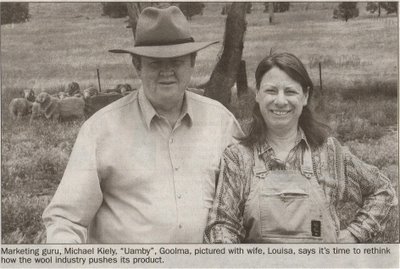 Why do I want that poisoned chalice? To live with the heartbreak of carefully conserving topsoil throughout the worst three years of drought in living memory, and feeding the sheep at a cost of many thousands of dollars, only to have the price fall from the highs of 1500 centres a kilo we received 4years ago through the average prices of 880 cents and down through 600 cents to languish around the 550 cents mark for so long.
Why do I want that poisoned chalice? To live with the heartbreak of carefully conserving topsoil throughout the worst three years of drought in living memory, and feeding the sheep at a cost of many thousands of dollars, only to have the price fall from the highs of 1500 centres a kilo we received 4years ago through the average prices of 880 cents and down through 600 cents to languish around the 550 cents mark for so long.The price is the scoreboard for the wool marketers. but wool has been much neglected by the people responsible for its selling because they still had their heads in the 1950s when the Korean War saw demand for our wool go through the roof and stay there for nearly a decade. Even small woolgrowers got rich. Wool was a pound a pound. They never recovered from that experience and they've been waiting for it to come back - through the years when the Government propped up the price artificially until there were 4 million bales in stockpile at Yennora in Sydney. The growers were seduced by a cargo cult mentality to believe the world owed them a high price. Heartbreaking for them, when you see the work they put in and the love for the fibre that drives them on. Heartbreaking. It's got to stop. It's a new world. We need new ideas. Not incremental changes, or shifts at the fringes. It needs a root and branch revolution. And we're the ones to turn it around.
 The press release that led to the visit of journalist Penny Zell was sent in November 2005. That's how long it can take to turn PR into printed story, even when you've got a good story.
The press release that led to the visit of journalist Penny Zell was sent in November 2005. That's how long it can take to turn PR into printed story, even when you've got a good story.
Saturday, April 22, 2006
At last! Some fencing for pasture improvement
Where last week we had 23 paddocks in the front section of "Uamby", from next week we will have 55 paddocks... Thanks to a plan by Daniel (pictured with Lucy, the apprentice sheepdog) and a wonderful contractor (to be profiled next week), and some advice from Col Seis (the pasture cropping guru) and some funding from the Catchment Management Authority (thanks guys), we will finally become a true time-controlled grazing operation.
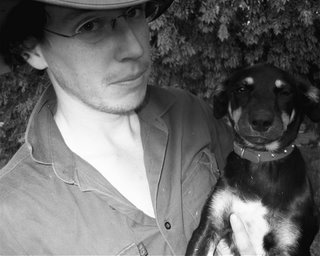
Time-controlled grazing (not rotational grazing) limits the amount of exposure each plant has to grazing and trampling to give it a chance to recover from a grazing incident. By concentrating the animals in a smaller paddock we force them to graze evenly (avoid 'patch grazing') on desirable and lesss desirable species. The tilling effect of their hooves and the fertilising effect of their dung and urine is maximised when they are bunched together in smaller paddocks - and the effect is miraculous. Graziers using these techniqaues commonly report 300% improvements in groundcover and species diversity and feed volumes.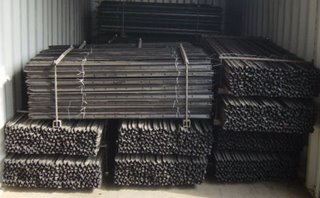
But all that fencing is expensive and we also need to have waterpoints in each paddock, so we have a mammoth taks ahead of us running water through the new layout. All up the entire process will cost $70 - $80,000. But the rewards are: better, healthier native pastures, better water retention in top soil, less erosion, less runoff and silting in waterways, less salination, faster sequestation of carbon in the soil, more and healthier microbial and microfauna communities in the soil, higher resistance to drought... the list goes on and on.
When we do the back 700 acres, we will have 80+ paddocks. And a lot of grass!

Time-controlled grazing (not rotational grazing) limits the amount of exposure each plant has to grazing and trampling to give it a chance to recover from a grazing incident. By concentrating the animals in a smaller paddock we force them to graze evenly (avoid 'patch grazing') on desirable and lesss desirable species. The tilling effect of their hooves and the fertilising effect of their dung and urine is maximised when they are bunched together in smaller paddocks - and the effect is miraculous. Graziers using these techniqaues commonly report 300% improvements in groundcover and species diversity and feed volumes.

But all that fencing is expensive and we also need to have waterpoints in each paddock, so we have a mammoth taks ahead of us running water through the new layout. All up the entire process will cost $70 - $80,000. But the rewards are: better, healthier native pastures, better water retention in top soil, less erosion, less runoff and silting in waterways, less salination, faster sequestation of carbon in the soil, more and healthier microbial and microfauna communities in the soil, higher resistance to drought... the list goes on and on.
When we do the back 700 acres, we will have 80+ paddocks. And a lot of grass!
Thursday, April 20, 2006
Easter Bunnies and Workaholics at "Uamby"
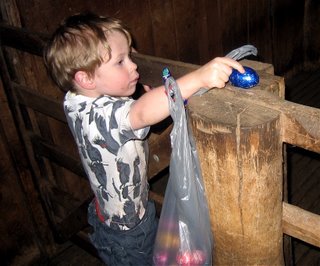 The Easter Bunny came to Uamby this year, but he hid the eggs in the shearing shed! My grandson the X-Man (Xavier) led us on an egg hunt to find the crafty hiding places EB (short for Easter Bunny, but actually my eldest daughter Jessica) had used to secret the eggies.
The Easter Bunny came to Uamby this year, but he hid the eggs in the shearing shed! My grandson the X-Man (Xavier) led us on an egg hunt to find the crafty hiding places EB (short for Easter Bunny, but actually my eldest daughter Jessica) had used to secret the eggies. Xavier had no competition, so he had a leisurely time. Wait until his sister arrives and is big enough to shoulder him about of the way in an all-out battle for chocolate!
Xavier had no competition, so he had a leisurely time. Wait until his sister arrives and is big enough to shoulder him about of the way in an all-out battle for chocolate!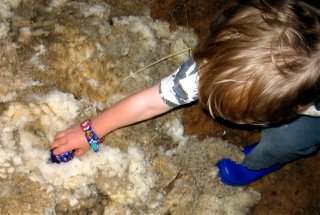
The little master is a very demanding but civilised chappie. He gave us the runaround while we are trying to potty-train him. He likes the convenience of nappies and can't get the idea of modern sanitation at all.
As part of his civilising, we forced him to give each of the adults, including Uncle Christopher, an egg. Chris is visiting for 10 days from Victoria where he is lighthouse keeper on Wilson’s Prom.
 Daniel and Liv walked the 20 kms into the Lighthouse and stayed with Chris earlier this year. Louisa and Chris's brother Breck walked in with his ladylove Robey and apparently both took it in their stride. Robey is a resilient woman and Breck is a new man, according to his stepmother Alex who reports that he made many overt expressions of love to Robey when they went to visit her prior to the Lighthouse adventure.
Daniel and Liv walked the 20 kms into the Lighthouse and stayed with Chris earlier this year. Louisa and Chris's brother Breck walked in with his ladylove Robey and apparently both took it in their stride. Robey is a resilient woman and Breck is a new man, according to his stepmother Alex who reports that he made many overt expressions of love to Robey when they went to visit her prior to the Lighthouse adventure.
Chris brought his new girlfriend Kerrie who is a good cook and not a looney like his last girlfriend who flipped over a quad bike chasing sheep and nearly broke her neck (attention seeking).

 Kerrie cooked an amazing leg of lamb last night - including Leatherwood Honey, English mustard and whole cloves of garlic. She also cooked a special chocolate cake for Chris's birthday.
Kerrie cooked an amazing leg of lamb last night - including Leatherwood Honey, English mustard and whole cloves of garlic. She also cooked a special chocolate cake for Chris's birthday. 
Chris is enjoying cutting trailer loads of wood for us to burn this winter. Being "Green Farmers", we try not to clear fallen timber because it provides a living environment for bugs and small reptiles, all the glorious diversity that Mother Nature loves. Chris is cutting fallen wood from just across the ramp on a next door neighbour's property. It's heavily wooded and between owners. Chris is a good worker. It's great to have workaholics in my wife's family who think of a week working for food and board as a holiday. I am a workaholic, my wife is, and y eldest daughter is. My son is not, nor it my youngest daughter. My grandson is a workaholic. He never stops, from dawn until well after dusk.
Easter assault on Bathurst Burr
 Fred and AManda had a lovely easter weekend hoeing Bathurst Burr at Uamby... They showed that they have the right stuff! (Fred is my protege - he runs a digital marketing company called Freestyle Media and I am their 'grey hair'. We had many marketing conversations over the vacation.)
Fred and AManda had a lovely easter weekend hoeing Bathurst Burr at Uamby... They showed that they have the right stuff! (Fred is my protege - he runs a digital marketing company called Freestyle Media and I am their 'grey hair'. We had many marketing conversations over the vacation.)  Fred was so enthusiastic he broke one of the new hoes I bought for the weekend.
Fred was so enthusiastic he broke one of the new hoes I bought for the weekend. And in true McLeod's Daughters style, my eldest daughter Jessica worked long and hard in the killing fields, but never letting the task interfere with her sense of style. I was grateful for every burr cut and stacked.
And in true McLeod's Daughters style, my eldest daughter Jessica worked long and hard in the killing fields, but never letting the task interfere with her sense of style. I was grateful for every burr cut and stacked.
Saturday, April 15, 2006
Pig's arse!

What do you do when the next door neighbour ambushes your son with a request to put their letterbox next to yours to save them travelling 3 kilometres to collect their mail? Uses the presumptive close? (In sales, it's called 'presumptive' because she says 'of course you won't mind...') Very pushy woman. We feel violated. We've learned the importance of keeping on the right side of the neighbours. These people are living on 50 acres and running a handful of cattle. Their little dog keeps coming here and harassing the female dogs. She assures us the mailbox will 'look good'. She later says it will be 'a little lamb'. OK, in the interests of peace, let them have it.
Then you arrive home to find a pig beside your letterbox. A twee, goofy, embarassing pig. The letters go in the front and she takes them out of a little trapdoor where its arse should be.
She's put us in a position where we can't win. Either we've got to insult her pedestrian sense of style or we have to say to the world: "We like this pig!"
I don't mind people expressing their eccentricity via their letterbox. But it is usually on their own doorstep. Why should we share their eccentricity by association?
Our options:
1. Remove it and tell them it was stolen.
2. Shoot it to pieces and say it was shooters.
3. Put a letter in it telling them to take it away.
4. Call them as ask them to remove it.
5. Deliver it back to them with a request to keep it off our place.
6. Tell them we changed our mind about letting them put a letter box there.
How would you handle this situation.
Wednesday, April 12, 2006
We have always been Green Farmers
We have always been Green Farmers, though we avoided the tag 'greenie' like the plague. Non-Green farmers are as superstitious about 'greenies' as people used to be about witches. When we first came to the Goolma district, we were considered a little queer and typecast as the rich wackos from the city... Nice people, but no idea! We had advisers and managers who told us everything we'd learned in Holistic Resource Management was wrong. Running the animals in one mob was wrong. Dividing the paddocks for rotational grazing was wrong. Letting native trees regrow was wrong. Refusing to plough arable land and sow crops was a wasted opportunity.
We didn't know what we were doing, but we were following our gut instincts that told us, "Dudes, you're dealing with Nature here. Nature. Get it?"
 And we had all around us the evidence that doing the same as everyone else would get us the same results. Bare earth. Erosion by wind and water. Salination. Species extinction.
And we had all around us the evidence that doing the same as everyone else would get us the same results. Bare earth. Erosion by wind and water. Salination. Species extinction.
We persevered rotating our sheep through 20-odd paddocks and trying new soil treatments to try to kick-start the biological activity down there. Some worked. Some didn't. We're in our 5th year here (our anniversary is tomorrow), and the fencing contractors are installing a further 30-odd paddocks, so we'll be really cooking with gas. But even before that happens, we've noticed a 'sea change' in grassland species and the emergence of a range of shrubs and flowing plants. While all around us a bring out their soils to feed their stock, we have plenty of dry standing feed. Col Seis, the pasture cropping guy, came out last week to check our new fencing plan for us and to look at the paddocks where we had tested pature cropping. Col said he noticed a dramatic increase in species in our pastures, too.
God loves Green Farmers. He loves the non-Green variety, too. But hey, he's God; he's got to.
We didn't know what we were doing, but we were following our gut instincts that told us, "Dudes, you're dealing with Nature here. Nature. Get it?"
 And we had all around us the evidence that doing the same as everyone else would get us the same results. Bare earth. Erosion by wind and water. Salination. Species extinction.
And we had all around us the evidence that doing the same as everyone else would get us the same results. Bare earth. Erosion by wind and water. Salination. Species extinction.We persevered rotating our sheep through 20-odd paddocks and trying new soil treatments to try to kick-start the biological activity down there. Some worked. Some didn't. We're in our 5th year here (our anniversary is tomorrow), and the fencing contractors are installing a further 30-odd paddocks, so we'll be really cooking with gas. But even before that happens, we've noticed a 'sea change' in grassland species and the emergence of a range of shrubs and flowing plants. While all around us a bring out their soils to feed their stock, we have plenty of dry standing feed. Col Seis, the pasture cropping guy, came out last week to check our new fencing plan for us and to look at the paddocks where we had tested pature cropping. Col said he noticed a dramatic increase in species in our pastures, too.
God loves Green Farmers. He loves the non-Green variety, too. But hey, he's God; he's got to.
Green Farmers Manifesto
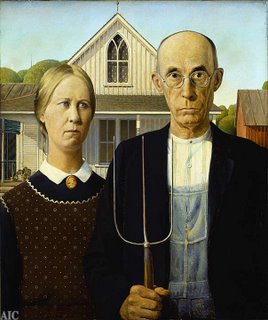
A "Green Farmer" is an "agricultural entrepreneur who profits by following natural processes".
The "Green Farmer" is a better capitalist than the non-Green variety because tomorrow's profit is as important as today's. The Green Farmer builds the natural resource base he exploits to make money. The non-Green farmer depletes his resources, like soil and water.
The Green Farmer avoids costly inputs such as chemical fertilisers and heavy use of herbicides and insecticides, weaning his animals and plants off these expensive, but temporary, quick fixes.
The "Green Farmer" tries to get out of Nature's way, while the non-Green farmer confronts nature and struggles against it.
The non-Green farmer gives farming a bad name. It's the non-Green farmer and his industry spokesmen who the environmental lobbyists point to when they demonise farming as a profession and call for so many of its practices to be banned.
If the public knew the work of the thousands of Green Farmers across Australia - of the tree planting and the wildlife corridors and the soil conservation and species protection and the regenerative agriculture and lets forget about 'sustainability', it's meaningless. (Sustaining a sick system is sustaining sickness.) It is RECUPERATIVE farming that is going on here, there and everywhere.
The mainstream rural newspapers mention rotational grazing in every issue. "Sustainable" agriculture has been bandied
 about 'til it has no meaning left... so it's a safe label for anyone. Imagine if all the associations and groups of farmers who take the natural path to riches - Green farmers all - formed a National Federation of Green Farmers. Imagine its members numbering in the thousands, to rival the NFF and associated bodies (who have a crisis of membership). Imagine the impact on public opinion when Green Farmers' Federation spokespersons are quoted taking a pro-nature stand on key issues.
about 'til it has no meaning left... so it's a safe label for anyone. Imagine if all the associations and groups of farmers who take the natural path to riches - Green farmers all - formed a National Federation of Green Farmers. Imagine its members numbering in the thousands, to rival the NFF and associated bodies (who have a crisis of membership). Imagine the impact on public opinion when Green Farmers' Federation spokespersons are quoted taking a pro-nature stand on key issues.We'd pull the rug out from under the "Green" lobby by stealing their name. We'd have them on toast because a lot of what they advocate runs counter to soil health and species survival - ie. locking land up and allowing trees to cover grassland species that cover the earth and prevent erosion. A commonsense voice in between the extremists. We would need to be broad church.
If we could recruit all those with experience in or practicing rotational grazing (HRM and GFP), organics, Natural Sequence Farming, Keyline Irrigation, Minimum-Till and No-Till Farming, Conservation Farming, Landcare members, Biological Farmers, Biodynamic operators, etc., what a force for good it could be.
It would be a loose federation of environmentally-conscious growers who are in the front ranks in the New Agricultural Revolution. No longer the weirdo next door or a secret society.
Leading agriculture out from under the crippling dominion of the pharmaceutical and petrochemical companies.
Friday, April 07, 2006
First Coalition Carbon scan underway
It's started! We have fired the first shot in our campaign to have soil carbon sequestration recognised as tradable carbon credits. We won't know for 3 years what degree of carbon sampling will be acceptable to the market, we are taking a conservative approach and measuring deep and measuring often. One metre deep and a core sample per acre.
To map the carbon in the topsoil at Uamby, we have commissioned The Center for Precision Agriculture, an august body of soil scientists from Sydney University, to do a pretty standard mapping exercise, using both an EM31 and an EM38 device and a Gamma machine which measures the various radioactive signatures to a depth.

The EM is a standard soil mapping instrument that can give us a guide as to where we should drill for core samples. The Gamma is still experimental but we are told that it has achieved good results in estimating carbon. (I will blog these devices later once I've done my homework.)
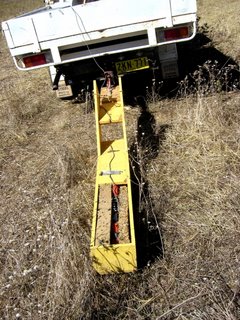
Why sample 100cm deep when 30cm is advised?
The 1m of core sample that we have proposed is insurance. 1cm to 30cm was to be sampled in 10 increments to get the data that DR Christine Jones said would be useful i.e the three horizons to see the relative activities of each level. The 30 to 100 cm horizon was taken purely to complete the data set.

Our largest problem at the moment is finding someone to test the soil. It seems the cheapest we can find is $36 per sample, making it unrealistic for the 3 horizons to be tested. We are not giving up on this though as it is very worth while having the top 30 cm separately tested.

From our research, the approach to carbon "Measurement, Monitoring and Verification" adopted across the world varies from a mere estimation based on computer modelling aall the way to our over-cautious approach. We are adopting our approach because we have got to convince the marketplace of our bona fides.
We'll keep you informed.
Driving the scanning rig is Michael Short from The Center for Precision Agriculture. Michael stayed with us for several days and had several adventures along the way. For instance, he drove across a rabbit warren which collapsed under him!

To map the carbon in the topsoil at Uamby, we have commissioned The Center for Precision Agriculture, an august body of soil scientists from Sydney University, to do a pretty standard mapping exercise, using both an EM31 and an EM38 device and a Gamma machine which measures the various radioactive signatures to a depth.

The EM is a standard soil mapping instrument that can give us a guide as to where we should drill for core samples. The Gamma is still experimental but we are told that it has achieved good results in estimating carbon. (I will blog these devices later once I've done my homework.)

Why sample 100cm deep when 30cm is advised?
The 1m of core sample that we have proposed is insurance. 1cm to 30cm was to be sampled in 10 increments to get the data that DR Christine Jones said would be useful i.e the three horizons to see the relative activities of each level. The 30 to 100 cm horizon was taken purely to complete the data set.

Our largest problem at the moment is finding someone to test the soil. It seems the cheapest we can find is $36 per sample, making it unrealistic for the 3 horizons to be tested. We are not giving up on this though as it is very worth while having the top 30 cm separately tested.

From our research, the approach to carbon "Measurement, Monitoring and Verification" adopted across the world varies from a mere estimation based on computer modelling aall the way to our over-cautious approach. We are adopting our approach because we have got to convince the marketplace of our bona fides.
We'll keep you informed.
Driving the scanning rig is Michael Short from The Center for Precision Agriculture. Michael stayed with us for several days and had several adventures along the way. For instance, he drove across a rabbit warren which collapsed under him!
Dog today, dog tomorrow
"Alas, Patch. I knew her, Horatio."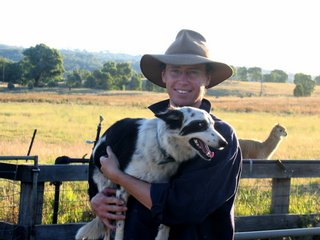 Patch has left the building. Daniel offered her to Len Cooney, but Len said he couldn't take such a good dog. He took one of the pups instead - called him "Techno". Dan offered Patch to our shearer Col Dougherty, but he's got too many dogs as it is. We didn't offer her to Dan Gorrie next door. He shoots his dogs. We just give em away. But Col was going crutching out near Cobar - and crutched wet sheep for a day and a half. He had a mate out there who could give Patch a lot of sheep work. She's a good paddock dog, but hopeless in the yards.
Patch has left the building. Daniel offered her to Len Cooney, but Len said he couldn't take such a good dog. He took one of the pups instead - called him "Techno". Dan offered Patch to our shearer Col Dougherty, but he's got too many dogs as it is. We didn't offer her to Dan Gorrie next door. He shoots his dogs. We just give em away. But Col was going crutching out near Cobar - and crutched wet sheep for a day and a half. He had a mate out there who could give Patch a lot of sheep work. She's a good paddock dog, but hopeless in the yards.
 Dan decided to keep two of the puppies (against all advice - you can't train two dogs at once, etc.). He called the sweet little bitch Lucy (on the left) and the male dog Jackson, after Michael Jackson, because he thinks he's cool (and he sleeps with chimpanzees. Kidding.) I wouldn't call my worst enemy a name after that freakshow.
Dan decided to keep two of the puppies (against all advice - you can't train two dogs at once, etc.). He called the sweet little bitch Lucy (on the left) and the male dog Jackson, after Michael Jackson, because he thinks he's cool (and he sleeps with chimpanzees. Kidding.) I wouldn't call my worst enemy a name after that freakshow.
Jackson and Lucy got straight into the flock at crutching a couple of weeks ago, and were almost trampled to death. But their genes say "Let's go round em up" and that's good. They are destructive little buggers, digging up the gardens and chewing up the shoes we leave at the door, or hiding them somewhere in the yard.
Want a puppie?
 Patch has left the building. Daniel offered her to Len Cooney, but Len said he couldn't take such a good dog. He took one of the pups instead - called him "Techno". Dan offered Patch to our shearer Col Dougherty, but he's got too many dogs as it is. We didn't offer her to Dan Gorrie next door. He shoots his dogs. We just give em away. But Col was going crutching out near Cobar - and crutched wet sheep for a day and a half. He had a mate out there who could give Patch a lot of sheep work. She's a good paddock dog, but hopeless in the yards.
Patch has left the building. Daniel offered her to Len Cooney, but Len said he couldn't take such a good dog. He took one of the pups instead - called him "Techno". Dan offered Patch to our shearer Col Dougherty, but he's got too many dogs as it is. We didn't offer her to Dan Gorrie next door. He shoots his dogs. We just give em away. But Col was going crutching out near Cobar - and crutched wet sheep for a day and a half. He had a mate out there who could give Patch a lot of sheep work. She's a good paddock dog, but hopeless in the yards. Dan decided to keep two of the puppies (against all advice - you can't train two dogs at once, etc.). He called the sweet little bitch Lucy (on the left) and the male dog Jackson, after Michael Jackson, because he thinks he's cool (and he sleeps with chimpanzees. Kidding.) I wouldn't call my worst enemy a name after that freakshow.
Dan decided to keep two of the puppies (against all advice - you can't train two dogs at once, etc.). He called the sweet little bitch Lucy (on the left) and the male dog Jackson, after Michael Jackson, because he thinks he's cool (and he sleeps with chimpanzees. Kidding.) I wouldn't call my worst enemy a name after that freakshow.Jackson and Lucy got straight into the flock at crutching a couple of weeks ago, and were almost trampled to death. But their genes say "Let's go round em up" and that's good. They are destructive little buggers, digging up the gardens and chewing up the shoes we leave at the door, or hiding them somewhere in the yard.
Want a puppie?
Wednesday, April 05, 2006
D-Day Minus 60

It's the agricultural version of the tv show "Survivor". Except 8 of the contestants will be voted off the island at the end of the show, which is now only 60 days away. This is our CMA Farming Systems class, 11 farm operations competing to come up with new ways to manage water to reduce salinity on the farm.
By now people are getting toey. No one knows for sure which way anyone will go, except for the Kielys of "Uamby" who posted their plan of attack on this blog, weeks ago.
(For those who missed earlier posts about this class, the Central West Catchment Management Authority - CWCMA - selected 11 farming families from 30+ applicants, for their opennesss to new ideas and their innovation on the farm. They are paying us $1000/day to attend classes on salination, water management, farm geology, soils, grazing and cropping issues, etc. And we are expected to produce, by 31 May, a whole-of-far plan which contains a new idea for managing water to reduce salt in the waterways of the State. This new idea has to be easily adapted by other farmers. Up to 3 of the entries will be funded up to $100,000 each to put the plan into action. All eyes are on the money!)
What hints do we have of innovative plans being developed? Not much. People have been playing their cards close to their chest. Some have been posturing and positioning themselves for a grab at the dollars. Some have complained that it's a race and said the $$$ should be shared out equally. I say "Let the games begin!"
We have opted to run our farm around the goal of lifting carbon levels in our soils, by whatever means a series of tests reveals is most effective for each soil type on our property. This entails mapping our farm for soil types, then core sampling it to measure the carbon as a baseline before testing treatments - such as rotational grazing, pasture cropping, application of nitrohumus (treated effluent), paramagnetic rock dust, biodynamics, complete rest, and whatever else comes to mind.
The mapping started today. (To prove we are serious we are spending $8,000 we haven't got to start the process. The core sampling will cost $44,000 because we are sampling 1000 acres at 1 sample per acre. Why so rigorous? To get our operation ready for Carbon Credits! Whatever the measuring/monitoring/verification methodology the market place goes wth, we want to be able to trade based on our increased carbon levels from the earliest date set for calculating amounts locked away.)
Some members of the class are tossing around ideas like edible shrubs that will aid biodiversity by providing an understory for bird life and also provide fodder for stock... At least 2 are thinking along these lines. Others are thinking about compost teas that you spray on fields. Again 2 are considering this. Bruce and Jenny are developing a wetland project on their horse property near Bathurst. Col Seis, the Father of Pasture Cropping, is expected to come up with an extension of this brilliant idea. Steve Kiss is toying with biodynamics. But the rest are sandbagging. Either they've got something hot, or they ain't got a lot.
I'll keep you posted.
Meanwhile we have the mapping to be completed this week, the fencing to start next week and the installation of the watering system (We are dividing the paddocks for rotational grazing - cell grazing using Holistic Resource Management principles)..>. More later.
Subscribe to:
Posts (Atom)



